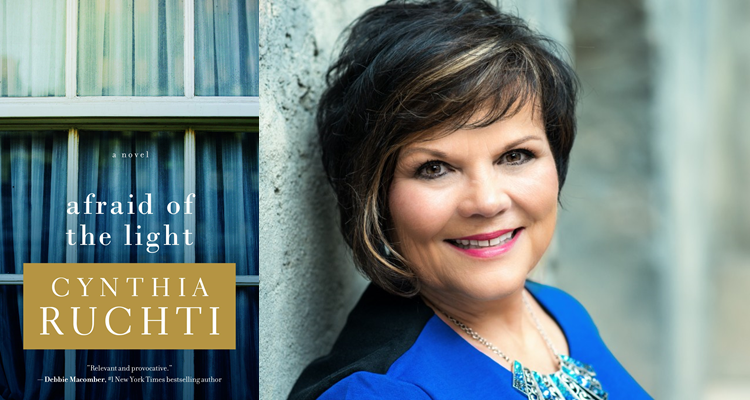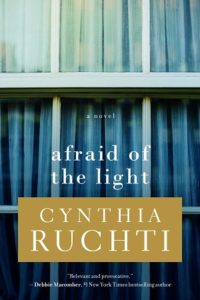The author talks about the importance of allowing the light of God to shine into the darkest corners of our lives.
Cynthia Ruchti tells stories of hope through novels, nonfiction, devotionals, and speaking events. Her latest novel is Afraid of the Light (Kregel Publications): Clinical psychologist Camille Brooks helps hoarders get organized and is famous for her creative coaching methods. But when a client raises long-dormant issues, can she face her fears, pull back the curtains, and let the light into her own life? In this interview, Cynthia talks about the real-life issues fueling the novel, the research she went through to understand the mental health issues behind hoarding, and the importance of allowing the light of God to shine into the “secret corridors of our soul.”
Cynthia, your novel Afraid of the Light has characters dealing with hoarding. Can you explain briefly what this is for readers who may be unfamiliar with the term?
In Afraid of the Light, Camille Brooks is a clinical psychologist who specializes in hoarding compulsions and disorders. Many of us have a stash of old vinyl albums or a collection of lunchboxes or salt and pepper shakers or vintage Valentines.
But a compulsive hoarder collects and accumulates to the point of creating emotional, mental, and health dangers for themselves and anyone else living in the house. Their disorder causes them to attach irrational value onto what others would consider worthless—broken chairs, used fast food wrappers, outdated newspapers, rain-soaked magazines. Mountains of them. A hoarding disorder—which falls under the category of anxiety disorders—means that for many, those items have unexplained worth.
Very real to the hoarder. Ridiculous or frustrating to the hoarder’s family members. The accumulation may make it impossible to navigate from room to room in the home. Rodents and insects find it a haven for them, which makes it a safety and health issue for the residents.
Like any addiction, hoarding takes over, making decisions for the addicted, destroying families, and turning some hoarders into hermits. They retreat from society and normal activities because they’re ashamed of what they’ve become, but feel powerless to stop.
They sequester themselves behind heavily curtained windows and bolted doors, not letting anyone in. The most severe hoarders are in essence afraid of the light.
Hoarding is a pretty intense state of being for people to live in. What inspired this angle of the story?
In recent years, I’ve been gripped by the reality that most of us shy away from or build walls between us and those whose mental health or grief issues are hard for us to understand. But Jesus took a different approach. Always. He plunged right in. He had conversations with hurting family members. He listened. And He offered hope.
Every novel I write takes me as the author on a personal journey of discovery. I knew there are stories behind the stacks and piles of a hoarder’s accumulation, and their attachment to those seemingly worthless objects. How could I grow in compassion and understanding if I walked with these characters through their healing journeys?
Did you do research? What was most challenging in preparing/writing the story?
This was a topic with which I had no personal experience, if you don’t count the half of my office that until recently was unnavigable. Shortly after staring the story, I began looking at everything with a “Do I really need this?” mentality.
But all of the hoarding disorder background came from intense research. I couldn’t rely on the sensationalized versions that often make headlines or show up on reality TV.
I needed both the personal perspective (from hoarders and their families) and the professional perspective from those who work with them. Yes, a lot of research and listening to people I know who are affected by parents or friends who struggle with the disorder.
Did you have any pre-suppositions about hoarding as you began your research?
Oh, the pre-suppositions! I had a level of compassion, I would have called it, assuming there’s always a story behind every pain, distress, or curious behavior.
But true compassion is entering into someone’s pain with them…and until writing Afraid of the Light, I viewed compulsive disorders and hoarding from a distance. A far distance. As it is with so many of us and so many topics, if we don’t understand it, we avoid it, or operate out of that false belief system, which helps no one and does nothing to strengthen our character.
I assumed hoarders possessed the power to stop hoarding, but didn’t want to. I assumed if they saw their home clean and tidy, they’d feel free rather than empty. I assumed their obsessions could be abandoned if they applied logic. And I did not know that behind almost every hoarding compulsion is deep trauma that either served as a catalyst or fuel.
I’m probably not the only person needing to change my “Eww!” response to a health hazard hoarder scene into an “Oh!” response with my hand pressed to my heart, leaning in to listen to the heart of a hoarder.
After the deep dive, did anything change in your ideas/attitude about this anxiety disorder?
Story has always been a powerful “compassionator,” empathy-stirrer, and character-builder in my life. Whether reading or writing a story, I expect to emerge from the experience changed in some way. And I was.
For one thing, I hadn’t seen hoarding as an anxiety disorder before. Change in perspective. I hadn’t fully embraced the family impact. And it was a revelation to note we’re all holding tightly to something (or a pile of things) that can become hazards to us. They trip us up spiritually, emotionally, relationally, or physically.
We stockpile blessings that others need. We hear there may be a toilet paper shortage and go back through the checkout line at the store to purchase another “two per customer limit.” We collect worries, turning them over in our minds until we’ve memorized their nuances and, in a twisted way, treasure them. We believe what we’ve accumulated doesn’t count as a “hoard” because we may actually need those items someday.
But we don’t. They pile up. A friend of mine often says, “Even cute piles up.”
When remodeling our 110-year-old farmhouse, everything in my 12×12 office had to be removed. Not just desk, printer, pens, envelopes, but EVERYTHING that had accumulated in the corners, behind the boxes where out-of-date but too-good-to-throw-away things went to die, and every single folder in the multiple filing cabinets.
What a task! What an eye-opener. I only let about 25 percent of it back into the office after the remodeling was complete. And it’s enough. More than enough. But for years, I’d assumed all that now was shredded, burned, given away, or discarded was vital. Or if not vital, at least of value.
Afraid of the Light wasn’t inspired by the Marie Kondo minimalism or de-cluttering craze. In some ways, minimalism can become its own obsession, as readers will see within the pages. But as I wrote the book and dealt with my own questions about real value versus perceived value, something clicked into place in my thinking.
Walking in the footsteps of the characters in the book–on their good days, their bad days, and their horrible no good awful desperate pain-wracked days–deepened my compassion for those whom society (and even family members) find hard to understand and seemingly impossible to reach.
Your main character, Camille Brooks, is a clinical psychologist. Did you go into the story knowing Camille was also going to be a hoarder?
Readers who haven’t opened the book yet may find that question startling, and wonder how she could help anyone. I believe all of us hoard something. If it isn’t objects, it’s grudges, or unforgiveness, or shame, or regret, or a toxic mix of all of the above. Camille’s struggles surprised her, and surprised me. But they’re very real, and they parallel her clients’ pain, but show up in unexpected ways.
Did any of the characters surprise you as you wrote the novel?
I didn’t expect how much I would come to adore Eli Rand, the garbage truck driver. His personality was delightful to write. His heart won me over. I think it will win over readers, too.
What were your goals in shaping the book and sharing Camille’s story?
I began this book having no more than what I thought would be the first several paragraphs (now one of Camille’s podcast episodes) and the very last lines of the book. All I needed were all the words in between.
As the story emerged, I began to see how important it was to give the hoarders a genuine, authentic voice, to let the family members’ reactions and reasons have their day in the sun, and to offer hope in what is often a hopeless situation. It was important for me that others would have an opportunity to consider not only an imaginative tale that would linger with them, but a fresh look at the stories behind the pain.
What would you like to be the readers’ takeaway after reading Afraid of the Light?
Even if we don’t deal with a severe hoarding disorder, we all know what it means to resist letting the light into our relationships or impulses or the secret corridors of our soul. We’re in many ways afraid of what the light will reveal. But the promise of God’s Word is that God is Light, and “in Him is no darkness at all,” 1 John 1:5 ESV. Fear loses its power to cripple us when it is exposed to His light.
Visit Cynthia Ruchti’s author page
https://www.familyfiction.com/authors/cynthia-ruchti
Afraid of the Light
Cynthia Ruchti
Kregel Publications
Clinical psychologist Camille Brooks isn’t put off by the lifestyle of her hoarder clients and the distress of their families. She lost her mother to the crippling anxiety disorder–so she’ll go a long way to help others avoid the same pain.
Despite Camille’s expertise, her growing audience for her Let In the Light podcast, and the recognition she’s gaining for her creative coaching methods, she’s not prepared for the pushback. A client who looks uncannily like her mom catches her off guard and raises long-dormant issues. And the revelation that Camille has her own hoarding problem sends her spinning.
With the help of a cadre of unexpected friends, an enigma of a man who refuses to be discouraged, and the God who created and loves her, can she face her fears, pull back the curtains, and let the light into her own life?



